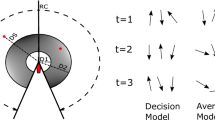Abstract
A system that operates as a whole through interactions between its constituent individuals, each of which operates autonomously, is called an autonomous decentralized system. This type of system is increasingly attracting attention in the fields of biology and engineering as a system that flexibly adapts to changes in external environments. In this paper, a push-forward model is proposed as a simple model to generate various collective motions in groups. The push-forward model can be used to generate four types of collective motions, including one where “if an individual flies out of the group, the direction in which the entire group is heading changes accordingly.” This motion could not be generated using conventional group models. In this study, the group collective motions obtained from the push-forward model are classified using evaluation indices, and the mechanisms of their development are discussed. Moreover, an evaluation is conducted using scale-free correlation, an index that expresses “group likeness,” which is derived from actual observations of bird flocks.
























Similar content being viewed by others
Explore related subjects
Discover the latest articles, news and stories from top researchers in related subjects.References
Tinbergen N (1951) The study of instinct. Oxford university Press, Oxford
Couzin ID et al (2002) Collective memory and spatial sorting in animal groups. J Theor Biol 218:1–11
Strömbom D et al (2017) Solving the shepherding problem: heuristics for herding autonomous, interacting agents. J R Soc Interface 11(100):20140719
Aoki I (1982) A simulation study on the schooling mechanism in fish. Bull Jpn Soc Sci Fish 48(8):1081–1088
Oboshi T, Kato S, Mutoh A, Itoh H (2003) A simulation study on the form of fish schooling for escape from predator. Forma 18(2):119–131
Nguyen LTH, Ta VT, Yagi A (2016) Obstacle avoiding patterns and cohesiveness of fish school. J Theor Biol 406:116–123
Aoki I (1980) An analysis of the schooling behavior of fish. Bull Ocean Res Inst 12:1–65
Partridge BL (1982) The structure and function of fish schools. Sci Am 246(6):114–123
Romey WL (1996) Individual differences make a difference in the trajectories of simulated schools of fish. Ecol Model 92:65–77
Couzin ID, Krause J (2003) Self-organization and collective behavior in vertebrates. Adv Stud Behav 32:1–75
Reynolds CW (1987) Flocks, herds, and schools: a distributed behavioral model. Comput Gr 22:25–33
Vicsek T, Czirok A, Jacob EB, Shochet O (1995) Novel type of phase transition in a system of self-driven particles. Phys Rev Lett 75:1226–1229
Niizato T, Gunji YP (2011) Metric-topological interaction model of collective behavior. Ecol Model 222:3041–3049
Ballerini M, Cabibbo V, Candelier R, Cisbani E, Dina IG, Lecomte V, Orlamdi A, Parisi G, Procaccini A, Viale M, Zdravkovic V (2008) Interaction ruling animal collective behavior depends on topological rather than metric distance: evidence from a field study. Proc Natl Acad Sci 105:1232–1237
Tunstrom K, Katz Y, Loannou C, Huepe C, Lutz J, Couzin D (2013) Collective states, multistability and transitional behavior in schooling fish. PLOS Comput Biol 9:e1002915
Couzin D, Loannou C, Demirel G, Gross T, Torney C, Hartnett A, Conradt L, Levin S, Leonard N (2011) Uninformed individuals promote democratic consensus in animal groups. Science 334:1578–1580
Murakami H, Tomaru T, Niizato T, Nishiyama Y, Sonoda K, Moriyama T, Gunji Y (2014) Collective behavior of soldier crab swarm in both ring- and round-shaped arenas. In: Proc. of the 20th international Symposium on Artificial Life and Robotics
Cavagna A (2010) Scale-free correlations in starling flocks. Proc Natl Acad Sci 107:11865–11870
Author information
Authors and Affiliations
Corresponding author
Additional information
Publisher's Note
Springer Nature remains neutral with regard to jurisdictional claims in published maps and institutional affiliations.
This paper was supported by JST CREST Grant Number JP- MJCR14D5, and JSPS KAKENHI Grant Number 18K13776, Japan.
About this article
Cite this article
Sueoka, Y., Sato, Y., Ishitani, M. et al. Analysis of push-forward model for swarm-like collective motions. Artif Life Robotics 24, 460–470 (2019). https://doi.org/10.1007/s10015-019-00548-8
Received:
Accepted:
Published:
Issue Date:
DOI: https://doi.org/10.1007/s10015-019-00548-8




